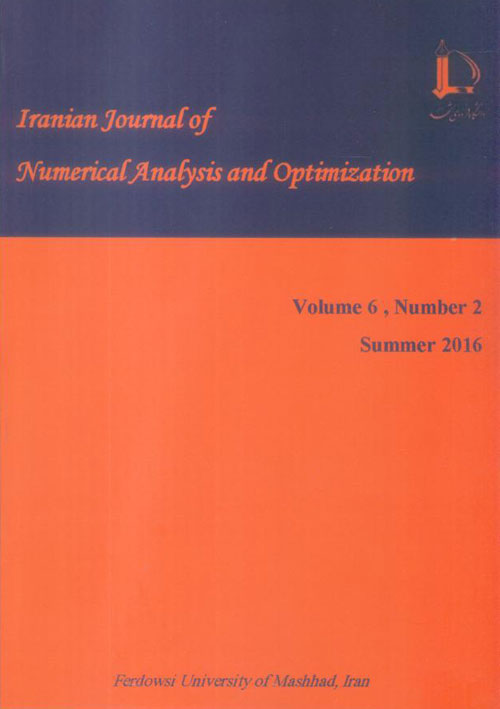فهرست مطالب

Iranian Journal of Numerical Analysis and Optimization
Volume:6 Issue: 2, Summer and Autumn 2016
- تاریخ انتشار: 1395/07/06
- تعداد عناوین: 7
-
-
Pages 1-16In this paper, the dynamic behavior of an immunosuppressive infection model, speci_cally AIDS, is analyzed. We show through a simple mathematical model that a sigmoidal CTL response can lead to the occurrence of transcritical bifurcation. This condition usually occurs in immunode_ciency virus infections (such as AIDS infection) in which viruses attack immune cells CD4. Our results imply that the dynamic interactions between the CTL immune response and HIV infection are very complex and in the CTL response, dynamics can exist the stable regions and unstable regions. At the end of the paper, numerical simulations are presented to illustrate the main results.Keywords: CTL response, HAM, TSP, Transcritical bifurcation
-
Pages 17-38This paper presents two numerical methods for solving the nonlinear constrained optimal control problems including quadratic performance index.
The methods are based upon linear B-spline functions. The properties of B-spline functions are presented. Two operational matrices of integration are introduced for related procedures. These matrices are then utilized to reduce the solution of the nonlinear constrained optimal control to a nonlinear programming one to which existing well-developed algorithms may be applied. Illustrative examples are included to demonstrate the validity and applicability of the presented techniques.Keywords: Optimal control problem, Linear B, spline function, Integration matrix, Collocation method -
Pages 39-50In this paper, sinc-collocation method is discussed to solve Volterra func tional integral equations with delay function (t). Also the existence and uniqueness of numerical solutions for these equations are provided. This method improves conventional results and achieves exponential convergence. Numerical results are included to confirm the efficiency and accuracy of the method.Keywords: Volterra functional integral equations, delay function, sinc, collocation
-
Pages 51-64When applying the non-stationary simultaneous iterative methods for solving an ill-posed set of linear equations, the error usually initially decreases but after some iterations, depending on the amount of noise in the data, and the degree of ill-posedness, it starts to increase. This phenomenon is called semi-convergence. We study the semi-convergence behavior of the non-stationary simultaneous iterative methods and obtain an upper bound for data error (noise error). Based on this bound, we propose new ways to specify the relaxation parameters to control the semi-convergence. The performance of our strategies is shown by examples taken from tomographic imaging.Keywords: Simultaneous iterative methods, Semi, convergence, Relaxation parameters, Tomographic imaging
-
Pages 65-84A numerical method to solve nonlinear quadratic integral equations (QIE) is presented in this work. The method is based upon modification of hat functions (MHFs) and their operational matrices. By using this approach and the collocation points, solving the nonlinear QIE reduces to solve a nonlinear system of algebraic equations. The proposed method does not need any integration for obtaining the constant coefficients. Hence, it can be applied in a simple and fast technique. Convergence analysis and associated theorems are considered. Some numerical examples illustrate the accuracy and computational efficiency of the proposed method.Keywords: Modication of hat functions, Nonlinear quadratic integral equation, Vector forms, Operational matrix, Error analysis
-
Pages 85-98The purpose of this research is to present a matrix method for solving system of linear Fredholm integro-differential equations(FIDEs) of the second kind on unbounded domain with degenerate kernels in terms of generalized Laguerre polynomials(GLPs). The method is based on the approximation of the truncated generalized Laguerre series. Then the system of (FIDEs) along with initial conditions are transformed into the matrix equations, which corresponds to a system of linear algebraic equations with the unknown generalized Laguerre coefficients. Combining these matrix equations and then olving the system yields the generalized Laguerre coefficients of the solution function. In addition, several numerical examples are given to demonstrate the validity, efficiency and applicability of the technique.Keywords: Systems of linear Fredholm integro, dierential equations, Un, bounded domain, Generalized Laguerre polynomials, Operational matrix of integration
-
Pages 99-120In this paper, we study the global truncation error of the linear multistep methods (LMM) in terms of local truncation error of the corresponding Runge-Kutta schemes. The key idea is the representation of LMM with a corresponding Runge-Kutta method. For this, we need to consider the multiple step of a linear multistep method as a single step in the corresponding Runge-Kutta method. Therefore, the global error estimation of a LMM through the Runge-Kutta method will be provided. In this estimation, we do not take into account the effects of roundoff errors. The numerical illustrations show the accuracy and efficiency of the given estimation.Keywords: Linear multistep methods, Runge, Kutta methods, Local trun, cation error, Global error, Error estimation

